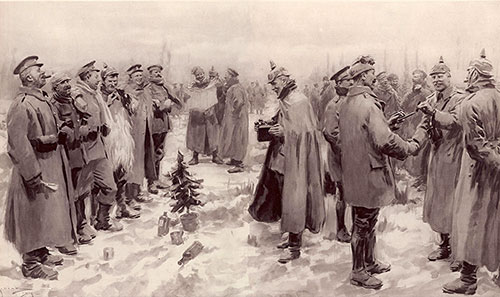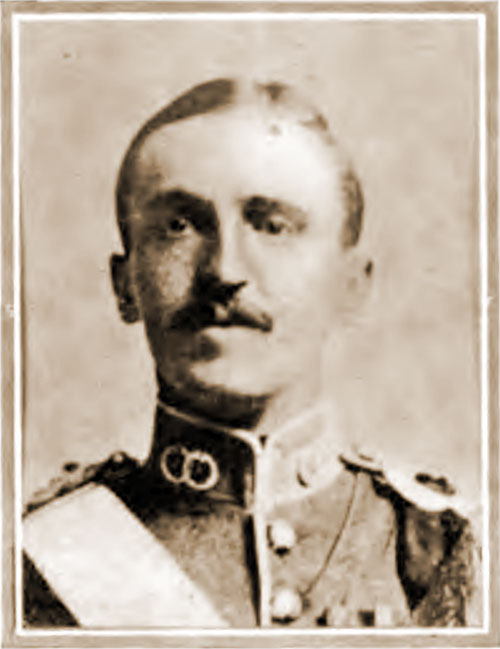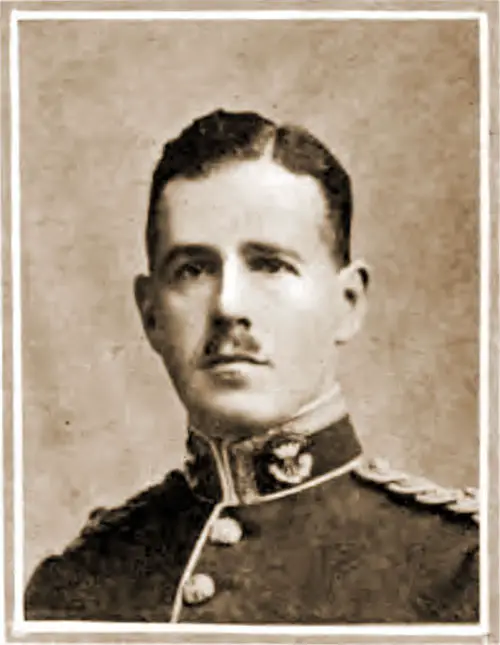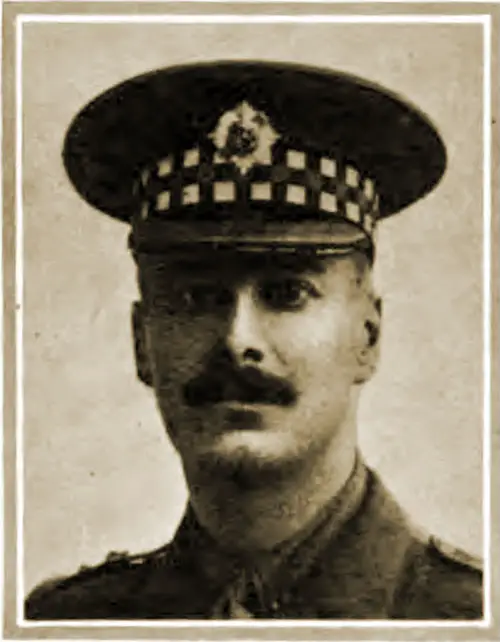The Christmas Truce of 1914

The Christmas Day Truce of 1914. British and German Soldiers Arm-in-arm Exchanging Headgear: a Christmas Truce between Opposing Trenches. Saxons and Anglo-Saxons Fraternizing on the Field of Battle at the Season of Peace and Goodwill: Officers and Men from the German and British Trenches Meet and Greet One Another—a German Officer Photographing a Group of Foes and Friends. Lithograph by Arthur C. Michael. Illustrated London News, 9 January 1915. GGA Image ID # 1889e3836d
The Christmas truce was a series of widespread unofficial ceasefires along the Western Front of the First World War around Christmas 1914. The truce occurred only five months into the war. According to Time Magazine, German and British troops celebrated Christmas together during this truce. (Time, 24 December 2014)

Captain William Alexander Henderson, 2nd Battn. Princess Louise’s (Argyll and Sutherland Highlanders), was born at Edinburgh on the 20th December, 1870, the son of the late Alexander Edward Henderson, Advocate, Sheriff - Substitute of the Lothians, and of Mrs. Henderson, Manor Place, Edinburgh.
He was educated at St. Salvator’s Preparatory School, St. Andrews, Loretto School, and Oriel College, Oxford, where he took his B.A. degree, and played golf for the University. He entered the 1st Battalion Argyll and Sutherland Highlanders in February, 1900, and served in the South African War, being a Station Staff Officer from July, 1901.
He was present at operations in the Transvaal, east and west of Pretoria, from July to November, 1900, including the action at Zilikat’s Nek; at further operations in the Transvaal, April, 1901, to May, 1902; and in Cape Colony in the latter month. He received the Queen’s medal with three clasps and the King’s medal with two clasps.
Captain Henderson was Adjutant of the 5th Seaforth Highlanders from 1910-13, when he returned to the 2nd Battalion of his regiment. He was at first reported wounded and missing after a night attack on a German trench at Ploegsteert Wood, near Armentières, early in the morning of the 10th November, 1914.
He was in command of the attack which has been described as a very gallant one. Over one hundred and thirty men of his command were killed, wounded, or missing after the attack.
On the 20th December, 1914, during the unofficial armistice at Christmas, his body, with fifteen bodies of his men, was found by the British and identified by the name in the coat, the identity disc and other articles having been taken by the Germans.
He was a keen cricketer and a well-known golfer, being a member of the Royal and Ancient Golf Club, St. Andrews. In 1909 he defeated J. O. Travers, the American champion, in the first round at Muirfield in the Amateur Golf Championship. He was a member of the Royal Automobile Club.
Captain Henderson married Constance May Chambers and left one son, Alexander Edward William, born June, 1912.

Captain Robert Clifford Orr, 3rd (attd. 1st) Battn. Prince Albert’s (Somerset Light Infantry), was the son of the late Robert Harrison Orr, Solicitor, of Belfast and Ballymena, County Antrim, and Cassandra Marchaise Orr, now residing at Rockside, Newcastle,Co. Down. He was a nephew of his Honour Judge Orr, County Court Judge for Co. Down. Captain Orr was born on the 17th September, 1880, at Belfast, and was educated at Sunningdale (Berks) Preparatory School and at Rugby.
He adopted the legal profession, and was admitted a Solicitor in 1903, practicing with his brother in Belfast and at Ballymena. In 1910 he was gazetted 2nd Lieutenant in the 3rd Battalion (Reserve) Somerset Light Infantry, being promoted Lieutenant in December, 1911, and Captain in October, 1914. Soon after the war broke out he was attached to the 1st Battalion of his regiment, and served with it at the front for about two months prior to his death.
Captain Orr was a member of the Ulster and the Ballymena Clubs, and of the Golf Club at the latter place. He was an active member of the Mid-Antrim Hunt Club, frequently acting as Master. He was also Captain of the local contingent of the Church Lads' Brigade.
He was killed on the 19th December, 1914, while leading his men in an attack on the German trenches outside Ploegsteert Wood, in Flanders. The following account of the circumstances was given to his brother by the Adjutant of his battalion :—
“ The company, in which your brother was, was ordered to lead the attack on the German trenches on the 19th December, 1914. After a heavy artillery bombardment all the morning the assault was made at 2.30 p.m.
"All the officers and men of this company, and the one which supported it, behaved with the utmost gallantry, but they were not successful in actually taking the German trenches, though several isolated parties, including one in which your brother was included, succeeded in breaking through the enemy’s wire entanglement and into a house held by the enemy.
"Nothing was known of your brother’s fate until Christmas Day. On this day an informal truce was arranged, and the Germans brought out from within their lines and handed over to us the body of your brother, amongst others, and we buried him in the little cemetery in Ploegsteert. Wood near our headquarters.
"I feel sure it will be a great comfort to his mother and yourself, as it was to us, to know that it had been possible to recover his body and bury him properly. There is no doubt that he must have very gallantly led his men practically into the German trenches, but we could not establish ourselves there, although we were able to advance our lines some distance as the result of the attack.”

Captain Hugh Taylor, 2nd Battn, Scots Guards, was the elder son of Mr. and Mrs. Taylor, of Chipchase Castle, Northumberland, and was born on the 24th December, 1880 . He was educated at Harrow and at Balliol College, Oxford , where he graduated with honours. He joined the Scots Guards in June, 1904, becoming Lieutenant in May, 1905, and Captain in November, 1914. Previous to the war he was Machine Gun Officer of his battalion, and on going to the front he became Brigade Machine Gun Officer.
He led his company in an attack near Rouges Bancs on the night of the 18th-19th December, 1914, and succeeded in reaching and occupying part of the German trenches. He returned alone to the British trenches to report, and while going back to rejoin his men was caught by machine-gun fire and killed instantaneously.
During the informal Christmas truce his body, which was lying near the German trenches, was brought over to the British lines by the Saxon soldiers with their heads bared, and was buried in the little military graveyard at La Cardonière Farm.
He was mentioned in Field-Marshal Sir John French’s Dispatch of the 14th January, 1915, for gallant and distinguished conduct.
It is interesting to note that on Christmas Day, when the Saxons and British soldiers met during their “ truce,” each side collected and brought the dead to the centre of the space between their respective lines.
Two trenches were dug, and the British and Saxon soldiers were buried, the English Chaplain reading the service, which was translated into German as he read. The soldiers afterwards fraternized for some hours.
Captain Taylor married, in 1907, Mary, daughter of Mr. Henry Villiers Stuart, of Dromana, and left a son and a daughter.
Colonel L. A. Clutterbuck, Ed., The Bond of Sacrifice: A Biographical Record of All British Officers Who Fell in the Great War, Volume 1: August-December 1914
